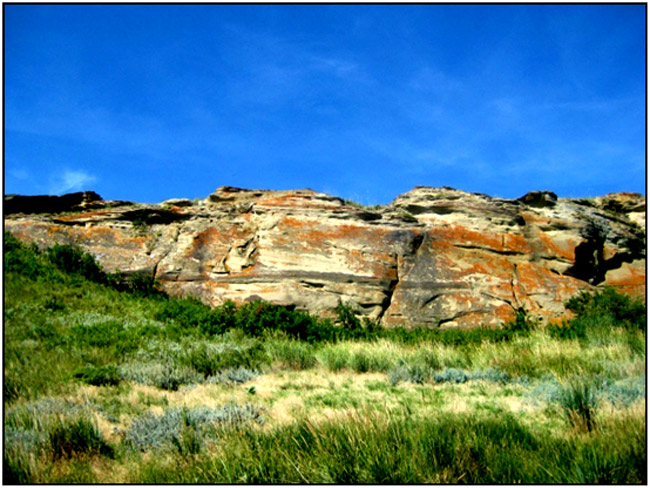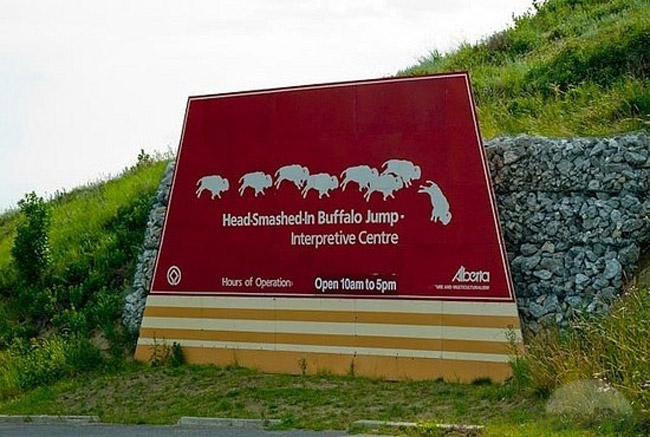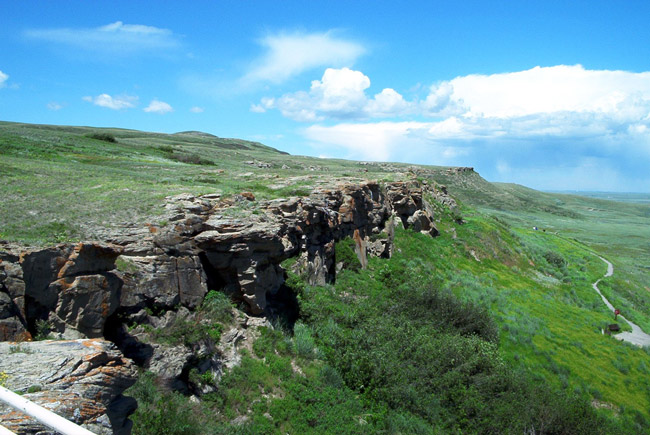Buffalo trap Head-Smashed-In - Canada
United Nations Science, Education and Culture Organization Unesco has recognized the trap area of Buffalo Head-Smashed-In of Canada is a World Cultural Heritage in 1981.
Area trap buffalo Head-Smashed-In - World cultural heritage in Canada
Head-Smashed-In buffalo trap area is located at the foot of the Rocky Mountains , which has an increasing height from the grassland above. Buffalo trap area is about 18 km northwest of Fort Macleod, Alberta.

Buffalo trap area was formed from nearly 6,000 years ago, scientists and archaeologists believe that the Head-Smashed-In buffalo trap area was used about 5,500 years ago. It was formed by indigenous people to kill buffaloes by driving them to a high cliff and letting them fall down to the cliff. The areas used to kill buffalos are usually about 11 meters high. For prehistoric people, the lack of necessary tools and tools for killing buffaloes to make meat become extremely difficult and difficult, because of that reason, the areas used to kill this buffalo are shaped. city.


Buffalo trap Head-Smashed-In is an area near the grazing area at Rorcupine hill. Indigenous people from thousands of years before grazing in this hill, when they want to kill buffaloes, they will move buffaloes in the direction of cliff slowly to climb up. Participants of "buffalo dragging" are often young people, selected to train and know very well about animal husbandry and animal behavior. These people will drive buffaloes to the predetermined path, monitor the behavior of the animals, so that the buffaloes run ahead will be pushed by the flock behind the plunger. Underneath these areas there are often jagged rocks, and the altitude decreases. The buffalos that fall into the pool are usually dead immediately or at least broke their legs and remain motionless. Buffaloes after falling into the pool will be transferred to a nearby farm for processing. Farms processing buffaloes are often located in the area, not far from the trap area. Buffaloes and buffalo meat processing areas always provide the necessary tools to serve the operation of buffaloes and slaughter, including fresh water.


The image of buffalo buffaloes in the buffalo trap shows how to kill human buffaloes thousands of years ago.
The ancients used buffalo meat to serve the needs of eating, buffalo bones after being removed from the meat used to make tools and houses, and the leather was made of clothes.
Buffalo trap Head-Smashed-In so it's not just a relic that people used to trap and kill buffaloes. This area is much more meaningful than merely providing food for life. It demonstrates the creativity and wisdom of the ancients - the time when livestock tools and slaughter were still very rudimentary. Not only that, this area also has a cultural and historical significance because it is a place to record proofs of Canadian Aboriginal life in a time.

Head traps Head-Smashed-In has been forgotten for a long time, especially since Europeans began to appear in this area. This place was mentioned again starting in 1880 by scientists and archaeologists. By 1938, for the first time, the area was excavated under the project of the American Museum of Natural History. It was not until 1968 that the Government of Canada officially recognized it as a historical site of the region, and in 1979 it was recognized as a national historical monument.


In 1987, the Government of Canada established the Head-Smashed-In Cultural Center , the center consists of different areas including natural areas which are the natural environment in the buffalo trap area and display area. , is the place to recreate the life, the trap of buffalo of the ancients. When visiting this center, visitors will visit the cliffs previously used to trap buffaloes and the area displays the skeletons, buffalo surgery tools and images of people's lives in area from thousands of years ago.




The center displays artifacts of buffalo slaughtering tools, buffalo traps and buffalo skeletons to serve tourists.
Buffalo trap Head-Smashed-In is recognized by Unesco according to criteria (vi); This is a large area and very well preserved, it not only has a historical value and is also a testament to how livestock, grazing, and slaughtering people 6,000 years ago.
- Wood Buffalo - Canada National Park
- 6 types of deadly pitfalls common in ancient tombs
- The world's most expensive bent horns cost $ 12 million
- Strange story about Buffalo
- Crocodile-head monster alone buffalo caused a stir in Thailand
- Wild buffalo buffalo elephants fly a few meters
- Buffalo buffalo hunters die to revenge for their fellow humans
- Video: The strange scene of crazy buffalo chasing the lion running crazy
- The bizarre, horny bull horn, the president does not sell
- The 4,300-year-old head statue was smashed by Egyptian pharaohs
- The lion hero chasing the whole buffalo herd and unexpected developments
- Improving internal stature
 Suzhou classic bonsai garden - China
Suzhou classic bonsai garden - China Chau Nguyen Dynasty
Chau Nguyen Dynasty Thai Son Mountain - World Wonder
Thai Son Mountain - World Wonder Ancient villages of Shirakawa-go and Gokayama
Ancient villages of Shirakawa-go and Gokayama